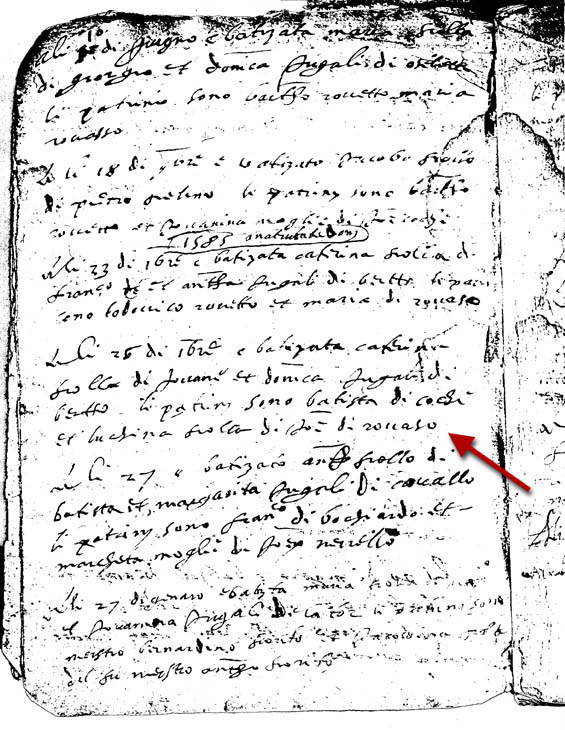THE
ROVASIOS ORIGIN LOCALITY: HISTORY OF THE ROVASIO AND THE COUNTRY.
by
Sergio Rovasio
First
of all let me start saying that the search I have carried out has allowed
me to learn many things. Looking for the information about the Rovasio
family name existed in the past, I found essential to begin the investigation
from my familiar nucleus, analyzing all the sources regarding the births
(and the deaths) of every male member. The search is possible because
people with the last name Rovasio are just a few. Not more than ten unit
are in Italy and, abroad, coming from Italy, a few dozens in Argentine
plus two familiar units in the United States: in California and the Connecticut.
An other unit could exists in New York. In base of the information collected
till now, the locality of origin of the Rovasio is Bardassano in Province
of Turin, in Piemonte, the origin region of my family. An other locality
of origin could be Asti since at least two familiar nuclei of Rovasio
think to be this the place of origin of their grandfathers. This unit
and the one from Sassari sustain that the surname come from 'Roasio'.
Other important traces are located in Turin and some surrounding town
Historical genealogy documentation has been collected mainly from Bardassano,
and just a little from Asti. The Rovasio lived to Bardassano were numerous
in the several generations followed in the centuries. The investigations
has its start from acquired information from all my relatives who live
in the locality, from the consultation of the registries of baptism of
the parish of Bardassano, also from information collected directly in
the locality, etc., etc.
The main important discover is the documented presence of the Rovasio
in this country at least from 1500. This is confirmed from the two main
trends of the search: the first one is that in the parish of Saint Michele
of Bardassano all the registries of baptism from the 1567 are conserved
today; unfortunately the registry from 1840 to 1880 is missing; the second
one according from the testimonies collected between the Rovasio relatives
who live in Gassino Turinese (a town that includes the fraction of Bardassano),
which they have direct testimony to have received from Mussolini two rewards
having been, continuously, for about four centuries, at the dependencies
of the Countess of the Bardassano Castle.
|
FARMSTEAD
"PARERI 'D FUND'"
This is the farmstead where two familiar nuclei of Rovasio have lived from the beginning of the 1800 until 1950. |
 |
|
Rovasio's
farm (Pareri 'd Fund) at Bardassano
|
THE
PARISH OF BARDASSANO'S DOCUMENTS
In 1990 I tried to gain information from personal data historical archive
of the Town Hall of GassinoTurinese, about the Rovasio been born in Bardassano.
The answer was negative. I then decided to try with the parish priest
of the Church of Bardassano. In 1995, thanks to the availability of the
caretakers of the catholic Church of Bardassano, I have had full access
to the historical archive of the baptism registries that, from nowadays,
goes back to the 1576, year in which the Catholic Church, in the Council
of Trento, decided to file all the names of the people who has been baptized
. They give me the permission to photocopy all the registries that contained
the Rovasio name. The documentation collected results to be primary to
the aims of the search. As I pointed out earlier, the missing registry
of the 1800, prevents to verify relations with Rovasios been born in the
same period, of other familiar unit and also of those migrated in other
countries. The baptism registry was written in Latin and, in the previous
period 1800, the name was written for the males in Roasio, Rovasium and
for the females Roasia, Rovasia.
The following image is the copy of the more ancient baptism registry dated
1567-1587 where, inside it appears, perhaps for the first time in a document,
the 'Rovaso' name: 'maria di rovasio' 1585 a.C.!!
|
Historical note It is important to know that the Roman Catholic church decide in the main Trento Council meeting, in 1563, to start to registry all baptisms. Before this activity was never done. In the medieval the civil laws was conforme with the Catholic Church wishes, so it is evident that everyone was convince to practice baptism. Another historical information, very important to highlight, is that in the medieval period only the upper level society members (church society , noble families, landowners) knew the alphabet, and the percentage of the analphabetism was very close to 100%. We can assume from this that only the people part of this upper society level, were allowed, and responsible, to keep all these documents (including books, general cultural information texts, council birth certificates). |
|
Some
transcribed the names in clear way, many are incomprehensible in the reading.
This important historical source demonstrates that Rovasio from Bardassano
are existed in this town at least from the 1500. Before me someone else
had already made this important discovery
THE ROVASIO OF BARDASSANO REWARDED FROM MUSSOLINI.
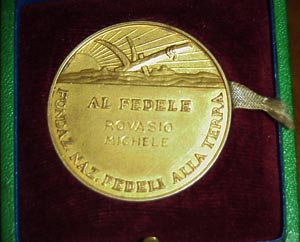 An
other trend of the search has been the interviews to all the knowing relatives
and parents live from the parts of Bardassano and, in particular in
An
other trend of the search has been the interviews to all the knowing relatives
and parents live from the parts of Bardassano and, in particular in 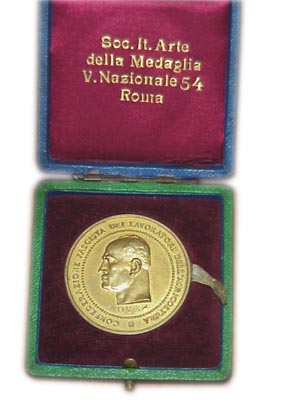 GassinoTurinese.
I discovered that in 1929 and/or in 1932 Mussolini in person gave two
awards to two Rovasio families in Gassino. It happened that a fascist
officer, called Bo from the town of Chivasso (town situated between Torino
and Gassino Turinese), discovered that the nucleus of the Rovasio families,
with all the local ramifications at the time, worked,for at least 4 centuries
consecutive,at the dependencies of the Bardassano Counts. They use to
be country workers. This fascist officer documented with precision, to
the aims of the awarding of the two prizes, the familiar union of the
Rovasio and their allocation in the place. The fascists valued to the
maximum the country workers production because at that time this was the
main resource of Italy. The produced documentation, and quite surely delivered
to the 'Fondazione Nazionale Fedeli della Terra' and/or to the 'Confederazione
Fascista Dei Lavoratori Dell' Agricoltura', it could exist somewhere.
The investigation in the Central Archive of the State in Rome did not
give any result. The first prize, consisting in a gold medal and thousand
Liras , reproduced here in the picture, was delivered in Rome, between
1929 and 1932, to Michele Rovasio (its grandfather was the brother of
my great-grandfather) and it is conserved today by Giovanni Rovasio, our
cousins living in GassinoTurinese. The other price, delivered to Carlo
Rovasio, Michele's cousins, (the grandfather of Carl was the brother of
the grandfather of Michele), consisted in a plate with written on ' Fedele
alla terra' ('Faithful to the Earth'). This award is now completely missing
GassinoTurinese.
I discovered that in 1929 and/or in 1932 Mussolini in person gave two
awards to two Rovasio families in Gassino. It happened that a fascist
officer, called Bo from the town of Chivasso (town situated between Torino
and Gassino Turinese), discovered that the nucleus of the Rovasio families,
with all the local ramifications at the time, worked,for at least 4 centuries
consecutive,at the dependencies of the Bardassano Counts. They use to
be country workers. This fascist officer documented with precision, to
the aims of the awarding of the two prizes, the familiar union of the
Rovasio and their allocation in the place. The fascists valued to the
maximum the country workers production because at that time this was the
main resource of Italy. The produced documentation, and quite surely delivered
to the 'Fondazione Nazionale Fedeli della Terra' and/or to the 'Confederazione
Fascista Dei Lavoratori Dell' Agricoltura', it could exist somewhere.
The investigation in the Central Archive of the State in Rome did not
give any result. The first prize, consisting in a gold medal and thousand
Liras , reproduced here in the picture, was delivered in Rome, between
1929 and 1932, to Michele Rovasio (its grandfather was the brother of
my great-grandfather) and it is conserved today by Giovanni Rovasio, our
cousins living in GassinoTurinese. The other price, delivered to Carlo
Rovasio, Michele's cousins, (the grandfather of Carl was the brother of
the grandfather of Michele), consisted in a plate with written on ' Fedele
alla terra' ('Faithful to the Earth'). This award is now completely missing
BARDASSANO - FRACTION OF GASSINO TURINESE
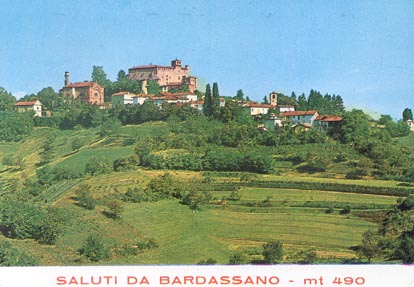 Bardassano
is a small village situated on a lovely hill , 452 meters height on the
sea level, dipped in the green, with less than 80
Bardassano
is a small village situated on a lovely hill , 452 meters height on the
sea level, dipped in the green, with less than 80 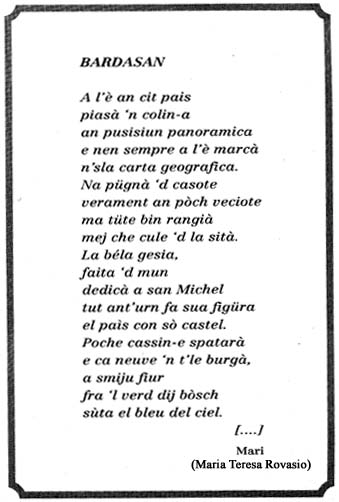 family
units correspondents to approximately 300 people. A medieval castle dominates
on the country . From 1600 to 1928 it has been an independent Council
and now is one of the fraction of Gassino Turinese. In 1954 the request
to return independent was rejected . The first official document that
defines the name of this town is from the period 1210-1220 originally
called 'Bardacanus seu Bardazanus', someone said that the original meaning
come from the word 'Baudazari' that means 'suffering'. From some historical
notes is possible to identify in a historic locality of the town a place
called 'bric of justice' where they used to keep all political prisoners
and the killed. Until 1600 the place was called in Latin 'Bardazani',
and subsequently it was transformed in the Italian version 'BARDASSANO.
THE BARDASSANO CASTLE'. The medieval Castle of Bardassano, today property
of the Count Giriodi Panissera, is dated 1200.
family
units correspondents to approximately 300 people. A medieval castle dominates
on the country . From 1600 to 1928 it has been an independent Council
and now is one of the fraction of Gassino Turinese. In 1954 the request
to return independent was rejected . The first official document that
defines the name of this town is from the period 1210-1220 originally
called 'Bardacanus seu Bardazanus', someone said that the original meaning
come from the word 'Baudazari' that means 'suffering'. From some historical
notes is possible to identify in a historic locality of the town a place
called 'bric of justice' where they used to keep all political prisoners
and the killed. Until 1600 the place was called in Latin 'Bardazani',
and subsequently it was transformed in the Italian version 'BARDASSANO.
THE BARDASSANO CASTLE'. The medieval Castle of Bardassano, today property
of the Count Giriodi Panissera, is dated 1200.
For long time it was transformed in prison from the Chieri Council after
demanding the ownership after arguments between aristocratic families.
Therefore it comes described in the 1700 property of the Castle in the
course of the centuries (drawn from a document of the volume of Francisco
Guasco, Marquis of Bisio): Piossasco paper from the Archive of the Bardassano
Castle , the following : The Bardassano Castle , after been property of
the Tondonito family, then property of the Chieri Council, included in
the private property of some aristocratic families, and then given under
investment on January 1489 to Antonio of Saumont or Submont, favorite
of duke Carl I, then , for a series of female successions, through the
family of Pesmes, Montemaggiore and Piossasco, reached the Panissera family
and, from these, the family of Giriodi Countess family for the wedding
of Giuseppina Panissera of Veglio with count Augusto Giriodi.
SHORT HISTORY OF BARDASSANO
 Beyond
to the historical trials and tribulations of the Castle, Bardassano has
had tormented moments of misery and poverty in its history. The people
living there often complained raids not only of criminal but of soldiers
and this period are allocated in these lands for long periods. From the
taxes and impositions of the noble premises, to the disseminated misery,
as a result of long natural calamities, the poverty often dominate between
the population. The country has lived long periods of emigration in more
fortunate places. It is worth mention some important facts of the history
of Bardassano between the 1600 and l800: - from the 1500 to the 1600 there
was in Bardassano the cemetery of people affected of tuberculosis from
all the province and Turin; - 1630: cases of plague are recorded in the
country; - 1642: revolt of all people living in the region against all
the cats holding the diseases; 1644: ban against the Gipsy that invaded
and destroyed the farmsteads of the poor country workers ; 1675: the Bardassano
population is 234 with 82 families and 22 cows; 1753 in an official document
of the state of the Council two people, respective with the Roasio and
Rovasio last name , are choose as Council Counselor in order to carry
out works with the town hall ; 1773: the hail from years destroys the
fields and bring misery between the country workers; 1818: between the
contributors they turn out to exist 163 owners of assets; 1826: it turn
out to be 56 defaulting people with the state treasury; 1858: it turn
out to be 668 members in the population
Beyond
to the historical trials and tribulations of the Castle, Bardassano has
had tormented moments of misery and poverty in its history. The people
living there often complained raids not only of criminal but of soldiers
and this period are allocated in these lands for long periods. From the
taxes and impositions of the noble premises, to the disseminated misery,
as a result of long natural calamities, the poverty often dominate between
the population. The country has lived long periods of emigration in more
fortunate places. It is worth mention some important facts of the history
of Bardassano between the 1600 and l800: - from the 1500 to the 1600 there
was in Bardassano the cemetery of people affected of tuberculosis from
all the province and Turin; - 1630: cases of plague are recorded in the
country; - 1642: revolt of all people living in the region against all
the cats holding the diseases; 1644: ban against the Gipsy that invaded
and destroyed the farmsteads of the poor country workers ; 1675: the Bardassano
population is 234 with 82 families and 22 cows; 1753 in an official document
of the state of the Council two people, respective with the Roasio and
Rovasio last name , are choose as Council Counselor in order to carry
out works with the town hall ; 1773: the hail from years destroys the
fields and bring misery between the country workers; 1818: between the
contributors they turn out to exist 163 owners of assets; 1826: it turn
out to be 56 defaulting people with the state treasury; 1858: it turn
out to be 668 members in the population
THE RELIGIOUS LIFE IN BARDASSANO
The
religious life dominant and much influential in the history of Bardassano,
is concentrated on two great traditions:
The protector of the town Saint Michele Arcangelo, which the parish church
is entitled. At the 'Longobardi' period, living in these lands for many
years. They venerated this saint because he was considered the most combatant.
Also the parish of Bardassano has lived its historical moments that were
alternated to tensions with the Bishop of Turin, for the decision to move
the parish within the Castle, at glorious moments, cause the construction
of the imposing new parish church to the end of 1700.
The other tradition regards the 'Confraternita dei disciplinati di San
Grato detti della Misericordia'. It was a true and own religious congregation
born and developed around 1600 in order to assist political prisoners
and the condemned to death in the Castle. The condemned who for mistake
were not killed from the executioner acquired the right to live in the
Confraternita.

